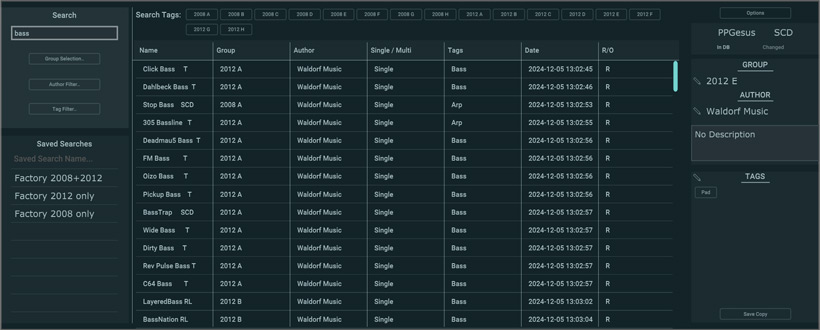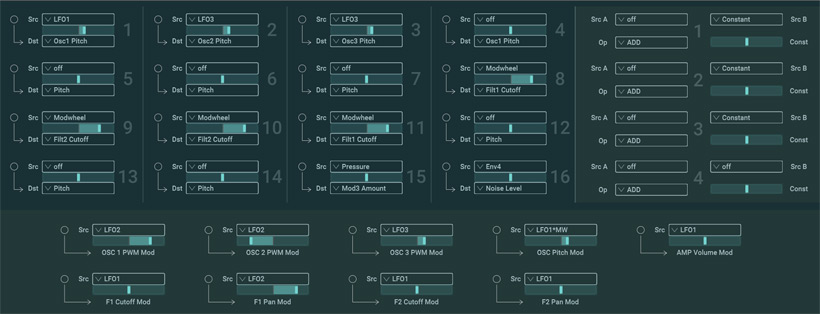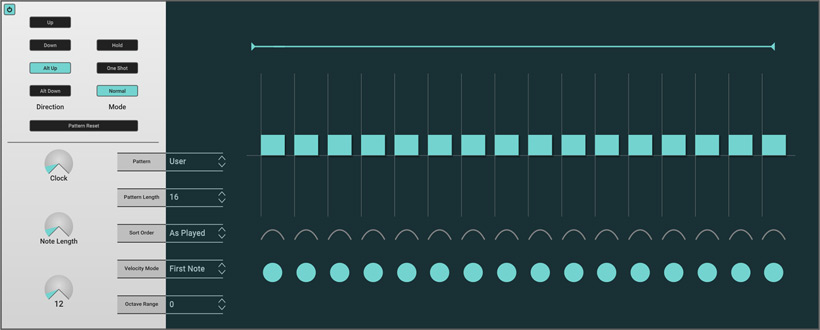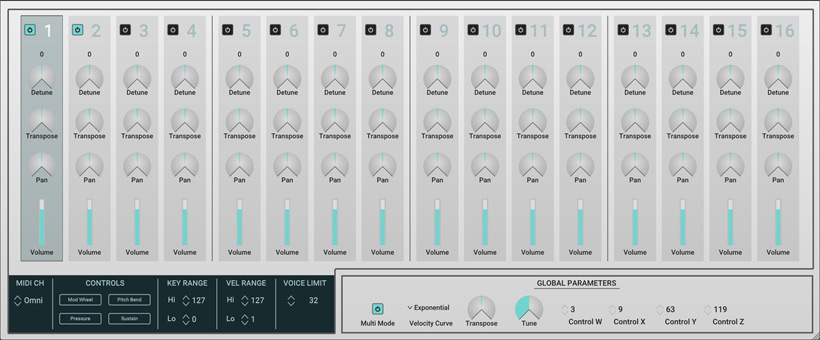Waldorf Music Blofeld Plug-In
Virtual instrument and editor
Author: Peter Kaminski
In December 2024, Waldorf introduced its Blofeld plug-in. Among other things, we have already tested the Microwaves 1 plug-in from Waldorf Music. This plug-in can also be used as an editor for the corresponding hardware. The same applies to the Blofeld plug-in. The difference is that the Blofeld synthesizers are still available.
Installation and licensing
The plug-in is available for macOS (from version 10.14) and Windows (from Windows 7) as VST, VST3, AAX, and (for macOS) also in AudioUnit plug-in format (version 2.0). The Blofeld plug-in be operated only in 64-bit host applications. There is no standalone version available.

Installation is done via an installer program (see above, Windows example).

When you purchase the plug-in, you will receive a code that you can redeem in your MyWaldorf account. This code must be entered together with the e-mail address of the associated MyWaldorf account after the first use in a host application (see figure above). The plug-in can be operated on up to three computers simultaneously.
Concept

The Blofeld from Waldorf will be available in a keyboard and a desktop version.
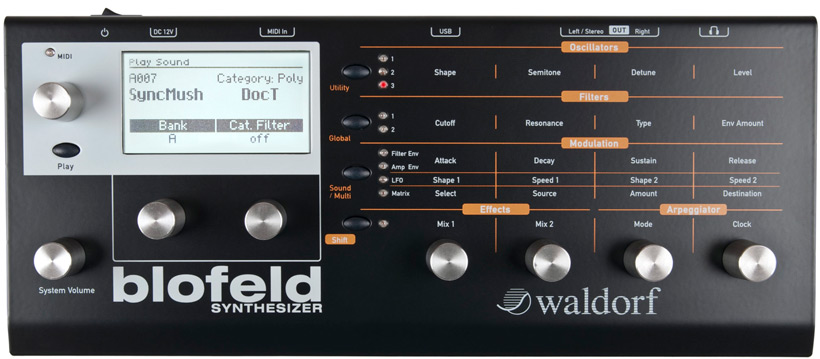
Many Waldorf synthesizers are based on the concept of the PPG synthesizers, such as the Waldorf Q, Micro Q, and Microwave, i.e., several wavetable-synthesis-based oscillators followed by filters and VCAs. The same applies to the Blofeld. The design uses three digital oscillators. However, instead of analog filters and VCAs, virtual ones realized via DSP are used. This makes it possible to use up to 25 voices.
Operation

At the top left, you can select a preset, and on the right, you can adjust the output level, which is also displayed on a small meter. In addition to that, you can select the individual operating pages and open a small menu for global settings. We will discuss the individual dialog pages in more detail later, except for the SAMPLE dialog page. Note that you can also edit samples directly in the plug-in.
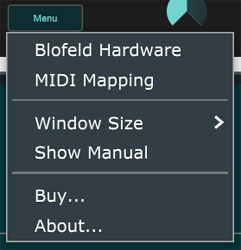
As mentioned earlier, the plug-in can also serve as an editor for a Blofeld hardware synthesizer connected via USB. The menu item “Blofeld Hardware” initiates the coupling. A dialog allows you to customize how the data should be synchronized.
The size of the plug-in window can be selected in three stages. However, the window can also be individually resized using the mouse.
Presets
Let’s start with the presets page. Here, you can create preset groups and your own tags for a more detailed description or classification of the presets.
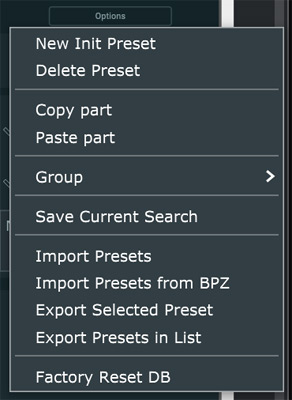
A menu allows you to delete, copy, import, and export presets. If a soundset also contains a bank file, you can load it. If this is done, all presets will be imported and a corresponding group will be created. More on this will be discussed in the practical part of this test.
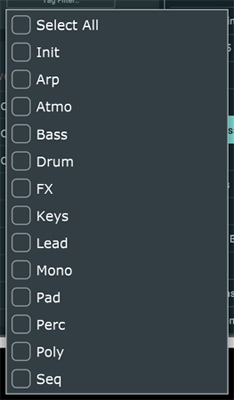
You can also search for various things or have the corresponding presets listed – for example, by group or tag (see figure above). You can also change the order in the list by clicking on the corresponding column heading. In addition, you can save your search queries and then retrieve them.
Oscillators and voices
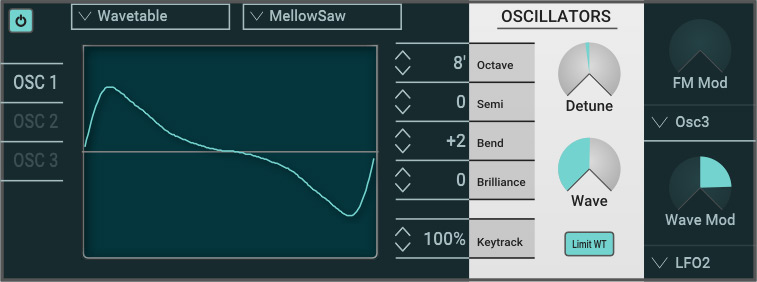
As mentioned above, Blofeld has three oscillators. The waveform is displayed graphically, and to the right of it, the pitch and key tracking can be set for each oscillator, as well as detuning, etc.
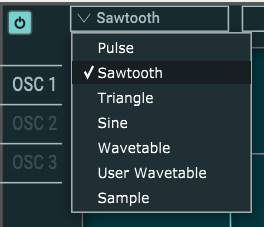
In addition to standard waveforms, wavetables (including self-created ones) and samples can be selected individually for each oscillator as a source.
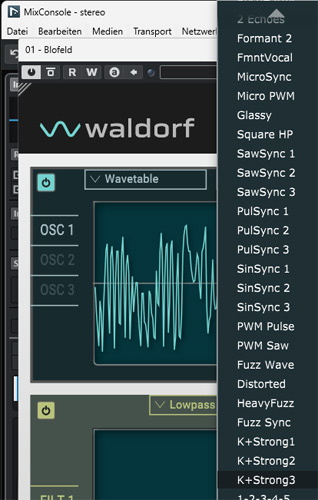
A large number of wavetables are included. The three wavetables labeled K+Strong 1 to 3 have a special status. These are not stored wavetables but three Karplus-Strong string synthesis algorithms that are calculated in real time.
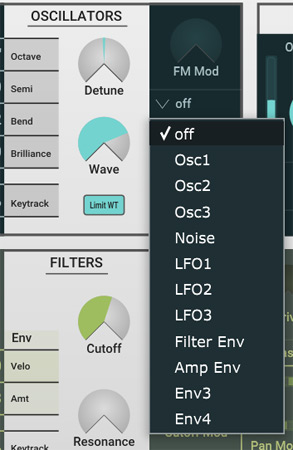
On the right side of the oscillator block, the modulation sources for frequency modulation and wavetable position can be selected (see figure above, example selection menu for FM source).
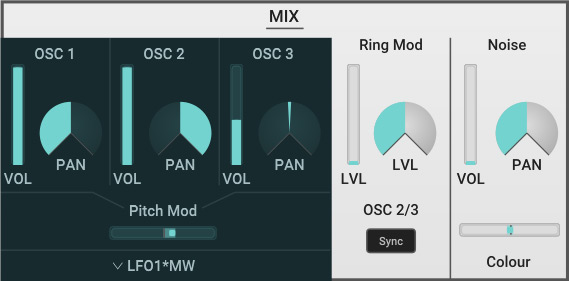
Each oscillator can be adjusted in level and stereo panorama in the MIX block. A ring modulator can also be used here and there is also a noise generator with adjustable coloration.
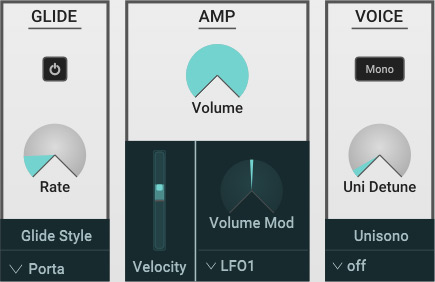
Further to the right, various keyboard parameters, such as glide and voice mode, can be set. In addition, there is also a virtual VCA.
Filter

Because the signal path is fortunately built in stereo, there are two filters that can be connected in series or in parallel. Also to be found here are various direct modulation options.
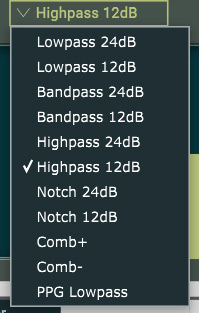
There are eleven different filter types to choose from. In addition to the typical filters found in synthesizers, there is also an all-pass filter and a filter simulation of the PPG Wave 2.
Envelopes and LFO

Blofeld offers four envelope generators and three LFOs.
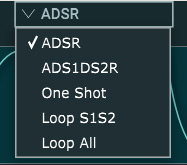
There are five different envelope modes (see figure above).
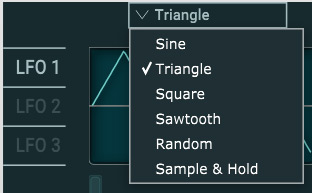
Each LFO offers six different modulation oscillator waveforms. Fortunately, these also include a random waveform and a sample & hold module.
Modulation Matrix
As you can see, there are various modulation options available directly in the individual function blocks. If that’s not enough for you, then you can also access a modulation matrix that is even more flexible.
Effects
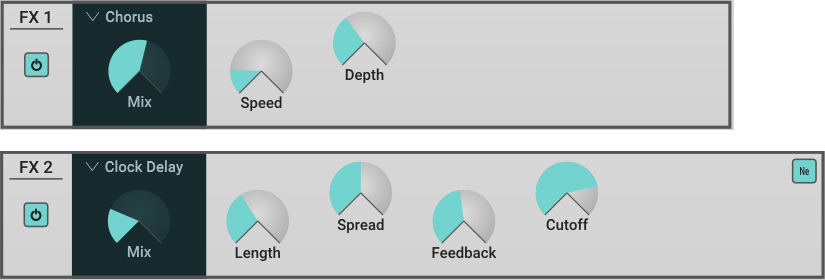
Blofeld also offers two effect blocks with different effects.
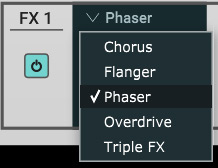
The first block offers overdrive and modulation effects.
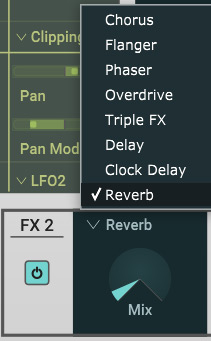
The second effect block also offers additional delay and reverb effects.
Arpeggiator
An arpeggiator is also available. However, it goes well beyond the capabilities of a normal arpeggiator and also includes sequencer functionality. The arpeggiator function can be activated either via the arpeggiator dialog page in the upper left corner above the virtual on/off switch or on the SYNTH page in the lower right corner of the arpeggiator section. The arpeggiator’s possibilities are so extensive that a detailed introduction would go beyond the scope of this test.
Multi
The Multi Mode can be activated via the MULTI page, where up to 16 so-called Multi Parts can be activated and set. The parameters that can be set here are Detune, Transpose, Panorama and Volume per Part. In the lower area, global settings can be made for all 16 parts. The parts can be overlaid or split.
Practice
We tested the plug-in under Windows 11 on an AudioKern B14 workstation from Digital Audio Service with Nuendo 13 as host software. There is a 70-page operating manual on the Waldorf website, which is accompanied by videos. An update to version 1.1.0 was released in mid-January, which solved many minor problems. For example, we had problems with the arpeggiator. After the update, we could no longer detect any errors. But some functions have also been added and improved, such as some relating to data transfer with the hardware synthesizer, where multi-presets are now also supported.
To operate the Blofeld plug-in with any degree of comfort, you have to use the largest of the three GUI sizes offered. The smallest is only a placeholder on the interface and doesn’t really allow operation. There is always a lot of information and parameters on one of the dialog pages. The plug-in is relatively intuitive to use after a short period of familiarization. However, for more complex topics, such as presets, arpeggiator, and importing soundsets, you should refer to the manual or available videos for more detailed information.
Anyone who has ever tried to program a complete preset on a Blofeld will quickly realize that the limitations of the hardware synthesizer’s display and user interface quickly become clear and you wish you had an editor. With the Blofeld plug-in, this wish has become a reality. I assume that every Blofeld user will be interested in the Blofeld Plug-In, because it not only offers the possibility of conveniently editing presets, but also preset management which offers convenient management options compared to the hardware. The Blofeld Plug-In is actually a must-have for every Blofeld hardware synthesizer user.
Let’s take a look at the preset organization. All of the presets that are available on the Blofeld hardware synthesizers are included, i.e., all presets from the 2008 and 2012 banks. Together, these are more than 1,000 presets. A soundset from sync_nyc with 20 presets is also included – many of them are more like effect sounds. However, we will briefly describe how to import these into the preset bank because they cannot be accessed directly after installing the plug-in.
After installing the plug-in, the soundsets, like all other soundsets from Waldorf Music, are stored in the “Program Data” folder in the “Waldorf” subfolder, and then for the Blofeld plug-in in the subfolder “Blofeld” and “Blofeld Sounds”. Each soundset has a separate subdirectory. If the folder Program Data is not visible on the system, you have to activate the option “Show hidden files, folders and drives” under Folder Options > View and create an alias of the “Program Data” folder and store it elsewhere for further use. You can now deactivate the option again because the created alias will remain visible.
So, how do you import a soundset? The procedure varies.

The synth_nyc soundset is specifically for the plug-in that is imported via “Import Presets from BPZ” by selecting the bank preset file (see figure above) and then all presets are imported and a group is automatically created (see figure below).

This differs for presets intended for the hardware. They should be copied manually into the appropriate subdirectory in the “Blodorf Sounds” folder. Then, you first create a group manually. The import is done via the menu item “Import Presets”. A dialog opens in which you can select any preset file in the corresponding directory. If a sample set is required for this purpose, then it must also be selected. This must also be done if the sample set for another sound set has already been loaded. Now you have to select the group you created earlier, and then the import can proceed.

It is now practical to search for the group after the import and to save this search (see figure above). It is noticeable that there is no direct option to add presets to your favorites. The preset management is very complex. Therefore, the user has various other options here. For example, you can create a tag for favorites and then assign this tag to the presets. This way, you won’t only have one favorites option, but many if needed.
As with the Microwave 1, the virtual instrument is very close to the original hardware in terms of sound. The Blofeld offers a very wide range of sounds. There is everything from fat-sounding analog synthesizers, basses, or pads to typical wavetable sounds, and percussive sounds are not neglected either.
One more note about optional presets: there are some from third-party providers, but Waldorf Music also offers a whole range of soundsets in its own shop (at the time of testing, there were 18 soundsets in the Waldorf shop). These were developed for the hardware synths but can be easily imported into the plug-in, as described above. We selected and imported three soundsets: Joerg Schaaf’s Blofeld Xperience Vol 1, Alian Vanguard, and Don Solaris Analog Voltage. These soundsets are all well worth the money. The three exemplary soundsets each contained around 130 presets. Although most of them are themed, the range of sounds is very wide. So it’s worth browsing through the shop. You can also listen to one or more demos for each soundset.
The modulation options on the Blofeld leave no wish to be unfulfilled. The combination of the direct modulation options in the function blocks and the modulation matrix for further limitless options is very successful. Some of you may be wondering how the Blofeld plug-in compares to the Microwave I plug-in. Of course, the two virtual instruments are similar in terms of their synthesis concepts, so there are some sonic similarities and overlaps, but there are also some distinguishing features. The Blofeld has three digital oscillators instead of two, as in the Microwave 1. The Microwave 1 also focuses more on the characteristics of wavetable synthesis and is perhaps even closer to the original PPG 2.0 in terms of sound. The modulation options for the Blofeld are certainly more extensive. If you already own the Microwave 1 plug-in, it’s no reason not to buy the Blofeld plug-in, and vice versa.
Conclusion
According to the manufacturer, the Blofeld virtual instrument costs 149 euros. The prices of the hardware: the desktop version is just over 500 euros, and the keyboard is just over 800 euros. If you own a Blofeld synthesizer and use it seriously, you can’t do without the plug-in and its editor functionality. But even for users who produce purely virtually, the Blofeld is extremely attractive because of its sonic possibilities and the multitude of included super-sounding factory presets.
 How to resolve AdBlock issue?
How to resolve AdBlock issue? 
